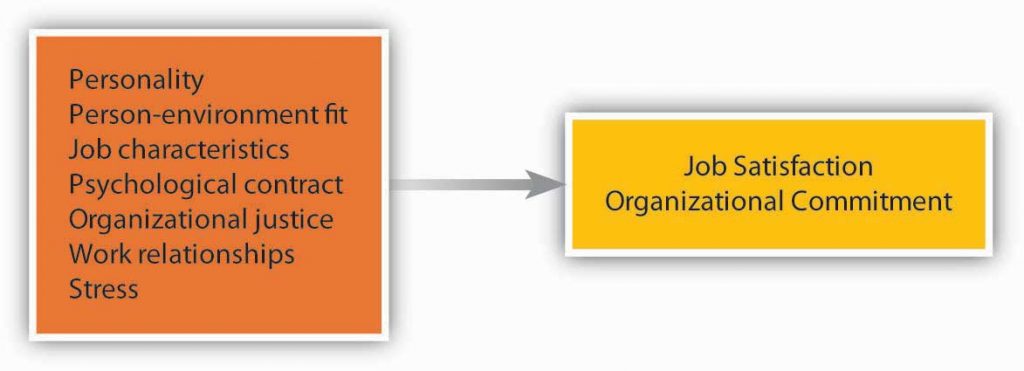2.5 Work Attitudes
Learning Objectives
- Define what work attitudes are.
- Define and differentiate between job satisfaction and organizational commitment.
- List several important factors influencing job satisfaction and organizational commitment.
- Identify two ways companies can track attitudes in the workplace.
How we behave at work often depends on how we feel about being there. Therefore, making sense of how people behave depends on understanding their work attitudes. An attitude refers to our opinions, beliefs, and feelings about aspects of our environment. We have attitudes toward the food we eat, people we meet, courses we take, and things we do. At work, two job attitudes have the greatest potential to influence how we behave. These are job satisfaction and organizational commitment.
Job satisfaction refers to the feelings people have toward their job. If the number of studies conducted on job satisfaction is an indicator, job satisfaction is probably the most important job attitude. Institutions such as Gallup or the Society for Human Resource Management (SHRM) periodically conduct studies of job satisfaction to track how satisfied employees are at work. According to a recent Gallup survey, 90% of the employees surveyed said that they were at least somewhat satisfied with their jobs. A recent SHRM study revealed 40% who were very satisfied (Sandberg, 2008).
Organizational commitment is the emotional attachment people have toward the company they work for. A highly committed employee is one who accepts and believes in the company’s values, is willing to put out the effort to meet the company’s goals, and has a strong desire to remain with the company. People who are committed to their company often refer to their company as “we” as opposed to “they” as in “in this company, we have great benefits.” The way we refer to the company indicates the type of attachment and identification we have with the company.
There is a high degree of overlap between job satisfaction and organizational commitment because things that make us happy with our job often make us more committed to the company as well. Companies believe that these attitudes are worth tracking because they often are associated with outcomes that are important to the Controlling role, such as performance, helping others, absenteeism, and turnover.
What Causes Positive Work Attitudes?
What makes you satisfied with your job and develop a commitment to your company? Research shows that people pay attention to several factors of their work environment, including characteristics of the job (a function of Organizing activities), how they are treated (related to Leadership actions), the relationships they form with colleagues and managers (also Leadership related), and the level of stress the job entails.
As we have seen earlier in this chapter, personality and values play important roles in how employees feel about their jobs.
Job Characteristics
Employees tend to be more satisfied and committed to jobs that involve certain characteristics. The ability to use a variety of skills, having autonomy at work, receiving feedback on the job, and performing a significant task, are some job characteristics that are related to satisfaction and commitment. However, the presence of these factors is not important for everyone. Some people have a high need for growth. These employees tend to be more satisfied when their jobs help them build new skills and improve (Loher et al., 1985; Mathieu & Zajac, 1990).
Organizational Justice and the Psychological Contract
A strong influence over our satisfaction level is how fairly we are treated. People pay attention to the fairness of company policies and procedures, fair and kind treatment from supervisors, and fairness of their pay and other rewards they receive from the company (Cohen-Charash & Spector, 2001; Colquitt et al., 2001; Meyer et al., 2002). Organizational justice can be classified into three categories: (1) procedural (fairness in the way policies and processes are carried out), (2) distributive (the allocation of resources or compensation and benefits), and (3) interactional (the degree to which people are treated with dignity and respect). At the root of organizational justice is trust, something that is easier to break than to repair if broken.
The psychological contract is the unspoken, informal understanding that an employee will contribute certain things to the organization (e.g., work ability and a willing attitude) and will receive certain things in return (e.g., reasonable pay and benefits). Under the psychological contract, an employee may believe that if he or she works hard and receives favorable performance evaluations, he or she will receive an annual bonus, periodic raises, and promotions, and will not be laid off. Since the “downsizing” trend of the past 20 years, many commentators have declared that the psychological contract is violated more often than not.
Relationships at Work
Two strong predictors of our happiness at work and commitment to the company are our relationships with coworkers and managers. The people we interact with, how friendly they are, whether we are socially accepted in our work group, and whether we are treated with respect by them are important to our happiness at work. Research also shows that our relationship with our manager, how considerate the manager is, and whether we build a trust-based relationship with our manager are critically important to our job satisfaction and organizational commitment (Bauer et al., 2007; Gerstner & Day, 1997; Judge et al., 2004; Kinicki et al., 2002; Mathieu & Zajac, 1990; Meyer et al., 2002; Rhoades & Eisenberger, 2002). When our manager and overall leadership listen to us, care about us, and value our opinions, we tend to feel good at work. When establishing effective relations with employees, little signals that you care about your employees go a long way. For example, in 2004 San Francisco’s Hotel Carlton was taken over and renovated by a new management group, Joie de Vivre Hospitality. One of the small things the new management did that created dramatic results was that, in response to an employee attitude survey, they replaced the old vacuum cleaners housekeepers were using and started replacing them every year. It did not cost the company much to replace old machinery, but this simple act of listening to employee problems and taking action went a long way to make employees feel better (Dvorak, 2007).
Stress

Not surprisingly, the amount of stress present in a job is related to employee satisfaction and commitment. Stressors range from environmental ones (noise, heat, inadequate ventilation) to interpersonal ones (organizational politics, conflicts with coworkers) to organizational ones (pressure to avoid making mistakes, worrying about the security of the job). Some jobs, such as intensive care unit nurse and military fighter pilot, are inherently very stressful.
Another source of stress has to do with the roles people are expected to fulfill on and off the job. Role ambiguity is uncertainty about what our responsibilities are in the job. Role conflict involves contradictory demands at work; it can also involve conflict between fulfilling one’s role as an employee and other roles in life, such as the role of parent, friend, or community volunteer.
Generally speaking, the higher the stress level, the lower job satisfaction tends to be. But not all stress is bad, and some stressors actually make us happier! For example, working under time pressure and having a high degree of responsibility are stressful, but they are also perceived as challenges and tend to be related to high levels of satisfaction (Kinicki et al., 2002; Meyer et al., 2002; Miller et al., 2008; Podsakoff et al., 2007).
Assessing Work Attitudes in the Workplace
Given that work attitudes may give us clues about who will leave or stay, who will perform better, and who will be more engaged, tracking satisfaction and commitment levels is a helpful step for companies. If there are companywide issues that make employees unhappy and disengaged, these need to be resolved. There are at least two systematic ways in which companies can track work attitudes: through attitude surveys and exit interviews. Companies such as KFC and Long John Silver restaurants, the SAS Institute, Google, and others give periodic attitude surveys, which are used to track employee work attitudes. Companies can get more out of these surveys if responses are held confidential. If employees become concerned that their individual responses will be shared with their immediate manager, they are less likely to respond honestly. Moreover, the success of these surveys depends on the credibility of management in the eye of employees. If leaders periodically collect these surveys but no action comes out of them, employees may adopt a more cynical attitude and start ignoring these surveys, hampering the success of future efforts. Exit interviews involve a meeting with the departing employee. This meeting is often conducted by a member of the human resource management department. If conducted well, this meeting may reveal what makes employees dissatisfied at work and give management clues about areas for improvement.
How strong is the attitude-behavior link? First of all, it depends on the attitude in question. Your attitudes toward your colleagues may influence whether you actually help them on a project, but they may not be a good predictor of whether you quit your job. Second, it is worth noting that attitudes are more strongly related to intentions to behave in a certain way, rather than actual behaviors. When you are dissatisfied with your job, you will have the intention to leave. Whether you actually leave will be a different story! Your leaving will depend on many factors, such as the availability of alternative jobs in the market, your employability in a different company, and sacrifices you have to make while changing jobs. Thus, while the attitudes assessed through employee satisfaction surveys and exit interviews can provide some basis for predicting how a person might behave in a job, remember that behavior is also strongly influenced by situational constraints.
Exercises
- What is the difference between job satisfaction and organizational commitment? How do the two concepts relate to one another?
- In your opinion, of the factors that influence work attitudes, which three are the most important in making people dissatisfied with their jobs? Which three are the most important relating to organizational commitment?
- Do you think making employees happier at work is a good way of motivating people? When would high satisfaction not be related to high performance?
- How important is pay in making people attached to a company and making employees satisfied?
- Do you think younger and older people are similar in what makes them happier at work and makes them committed to their companies? Do you think there are male-female differences? Explain your answers.
Key Takeaways
“Work Attitudes” in Principles of Management by University of Minnesota is licensed under a Creative Commons Attribution-NonCommercial-ShareAlike 4.0 International License, except where otherwise noted.


